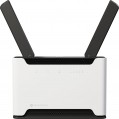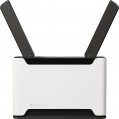Add to comparison |  |  |
|---|---|---|
| MikroTik Chateau LTE6 ax | MikroTik Chateau LTE18 ax | |
| Compare prices 2 | Compare prices 3 | |
| TOP sellers | ||
| Product type | router | router |
| Data input (WAN-port) | Ethernet (RJ45) Wi-Fi SIM card | Ethernet (RJ45) Wi-Fi SIM card |
| 4G speed (LTE) | Cat.6 (300/50 Mbps) | Cat.18 (1200/210 Mbps) |
Wireless Wi-Fi connection | ||
| Wi-Fi standards | Wi-Fi 3 (802.11g) Wi-Fi 4 (802.11n) Wi-Fi 5 (802.11ac) Wi-Fi 6 (802.11ax) | Wi-Fi 3 (802.11g) Wi-Fi 4 (802.11n) Wi-Fi 5 (802.11ac) Wi-Fi 6 (802.11ax) |
| Frequency band | 2.4GHz 5 GHz | 2.4GHz 5 GHz |
| Operating ranges | dual-band (2.4 GHz and 5 GHz) | dual-band (2.4 GHz and 5 GHz) |
| Wireless speed 2.4 GHz | 574 Mbps | 574 Mbps |
| Wireless speed 5 GHz | 1200 Mbps | 1200 Mbps |
Connection and LAN | ||
| LAN | 5 ports 1 Gbps, 2.5 Gbps | 5 ports 1 Gbps, 2.5 Gbps |
| Reassignable WAN / LAN | 5 ports | 5 ports |
| USB 2.0 | 1 | 1 |
Antenna and transmitter | ||
| Number of antennas | 2 | 2 |
| Antenna type | external | external |
| MU-MIMO | ||
| Detachable antenna | ||
| Gain | 6 dBi | 6 dBi |
| Antennas (mobile internet) | internal | internal |
| Transmitter power | 21 dBm | 21 dBm |
| Signal strength 2.4 GHz | 20 dBm | 20 dBm |
| Signal strength 5 GHz | 21 dBm | 21 dBm |
Hardware | ||
| CPU | Qualcomm IPQ-6010 | Qualcomm IPQ-6010 |
| CPU cores | 4 | 4 |
| Clock Speed | 1.8 GHz | 1.8 GHz |
| RAM | 1 GB | 1 GB |
| Flash memory | 128 MB | 128 MB |
Functions | ||
| Features | NAT bridge mode Beamforming firewall CLI (Telnet) | NAT bridge mode Beamforming firewall CLI (Telnet) |
| More features | DHCP server file server VPN DDNS | DHCP server file server VPN DDNS |
Security | ||
| Safety standards | WPA WEP WPA2 WPA3 | WPA WEP WPA2 WPA3 |
General | ||
| Power consumption | 17 W | 19 W |
| Operating temperature | -40 °C ~ +70 °C | -40 °C ~ +65 °C |
| Dimensions | 240х156х44 mm | 240х156х44 mm |
| Color | ||
| Added to E-Catalog | june 2023 | november 2022 |